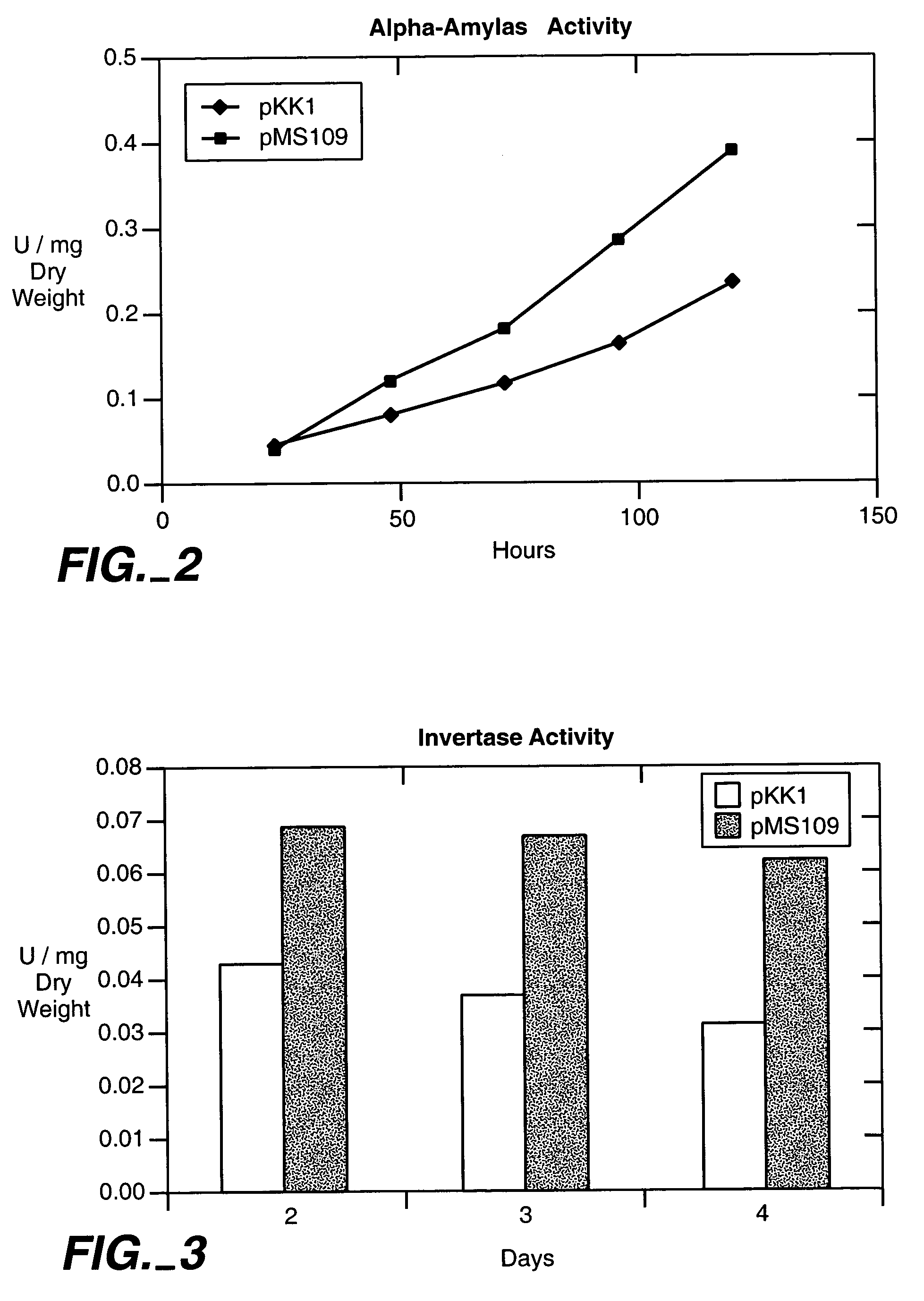Increased production of secreted proteins by recombinant eukaryotic cells
a technology of recombinant eukaryotic cells and secreted proteins, which is applied in the direction of peptides, enzymology, transferases, etc., can solve the problems of limited success in achieving increased secretion and achieve the effect of facilitating cloning and constitutive induction of the unfolded protein respons
- Summary
- Abstract
- Description
- Claims
- Application Information
AI Technical Summary
Benefits of technology
Problems solved by technology
Method used
Image
Examples
example 1
Effect of Expression of Truncated HAC1 in Yeast
[0108]In order to cause constitutive induction of the unfolded protein response in Saccharomyces cerevisiae, a truncated version of the yeast HAC1 gene was expressed from a centromeric plasmid. The truncated version does not include the intron of HAC1 that in normal conditions prevents the translation of the mRNA. Thus the mRNA expressed from the plasmid is translated to HAC1 protein constitutively and causes a constitutive induction of the unfolded protein response. The appropriate HAC1 gene fragment was first amplified from yeast chromosomal DNA by PCR. This fragment starts 24 bp before the translation start codon of the HAC1 gene and ends with a translation stop codon inserted after the proline codon at amino acid position 220 of the deduced protein. The oligonucleotide primers used were: 5′ ATC GCA GGA TTC CCA CCT ACG ACA ACA ACC GCC ACT 3′ (forward primer) (SEQ ID No. 20) and 5′ TAC AGC GGA TCC CTA TGG ATT ACG CCA ATT GTC AAG3′ (re...
example 2
Effect of Disruption of HAC1 in Yeast
[0111]The yeast HAC1 gene was disrupted by replacing it in the genome with a DNA fragment containing the G418 antibiotic resistance cassette flanked by 48 bp sequences from the 5′ and 3′ ends of the HAC1 open reading frame. The G418 resistance cassette consists of the E. coli kanamycin resistance gene cloned between the promoter and terminator of the Ashbya gossypii TEF gene encoding translation elongation factor 1. The DNA fragment used in the disruption of the yeast HAC1 was produced by PCR from the kanMX2 module (Wach et al.,1994, Yeast 10, 1793-1808) with the oligonucleotide primers 5′ CCA CCT ACG ACA ACA ACC GCC ACT ATG GAA ATG ACT GAT TTT GAA CTA CTT GCC TCG TCC CCG CCG GGT CAC 3′ (forward primer) (SEQ ID No. 22) and 5′ AAT TAT ACC CTC TTG CGA TTG TCT TCA TGA AGT GAT GAA GAA ATC ATT GAC ACT GGA TGG CGG CGT TAG TAT CGA 3′ (reverse primer) (SEQ ID No. 23). The PCR reaction was done with the Dynazyme DNA polymerase (Finnzymes) in conditions re...
example 3
Cloning and Sequence of the Aspergillus nidulans hacA and Trichoderma reesei HAC1 Genes
[0113]A homology search was performed against a public database (http: / / bioinfo.okstate.edu / pipeonline.db / anesguery.html )containing Aspergillus nidulans EST (expressed sequence tag) sequences with the yeast HAC1 protein sequence using the program BLAST (Altschul et al., 1990, J. Mol. Biol. 215,403-410). The search identified one EST cDNA clone (c7a10a1.r1) which has homology to yeast HAC1p at the DNA binding domain. However, another region of the same cDNA clone, designated as EST c7a10a1.f1 in the database, had no obvious similarity with HAC1 and there was no annotation within the database to indicate similarity between the ESTs and HAC1. Therefore, it was unclear if the A. nidulans cDNA clone encoded a functional homolog of HAC1 or a different protein having a version of a DNA-binding motif. The region corresponding to the c7a10a1 EST cDNA was amplified by PCR from A. nidulans genomic DNA isola...
PUM
| Property | Measurement | Unit |
|---|---|---|
| temperature | aaaaa | aaaaa |
| pH | aaaaa | aaaaa |
| pH | aaaaa | aaaaa |
Abstract
Description
Claims
Application Information
 Login to View More
Login to View More - R&D
- Intellectual Property
- Life Sciences
- Materials
- Tech Scout
- Unparalleled Data Quality
- Higher Quality Content
- 60% Fewer Hallucinations
Browse by: Latest US Patents, China's latest patents, Technical Efficacy Thesaurus, Application Domain, Technology Topic, Popular Technical Reports.
© 2025 PatSnap. All rights reserved.Legal|Privacy policy|Modern Slavery Act Transparency Statement|Sitemap|About US| Contact US: help@patsnap.com



